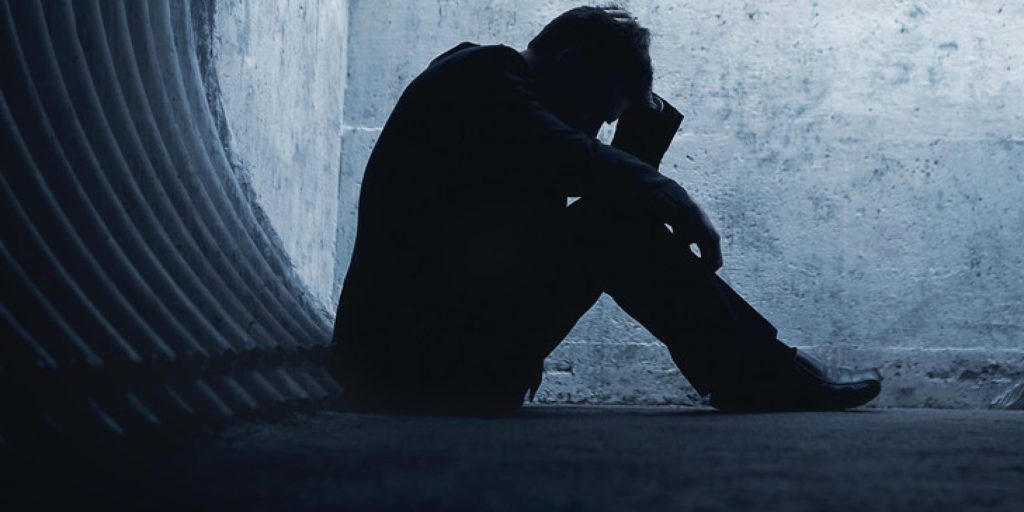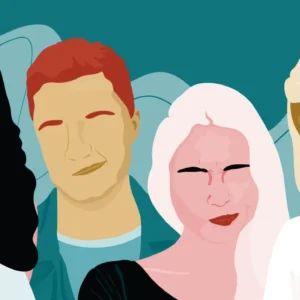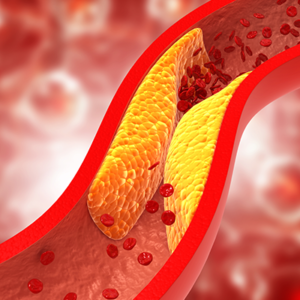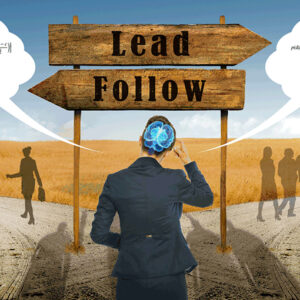
Depression affects 5 out of 100 people in the world (about 322 million people); it has a higher incidence in the female population (3 out of 4 patients, about 75%) aged between 55 and 74 years (WHO data) and would more frequently affect the West and South-East Asia.
In Italy, the incidence of the disorder would be 2.8 million people (about 5–6% of the population), calculated by the National Institute of Statistics. Il Sole 24 ore in 2018 estimated that in 2030 depression could represent the major cause of disability in the world.

What is Depression?
It is a clinical condition recognizable through the following symptoms (APA, 2013) :
- depressed mood most of the day, most days;
- markedly decreased interest or pleasure in all, or nearly all, activities; significant weight loss or weight gain (or appetite);
- insomnia or hypersomnia;
- psychomotor agitation or retardation;
- Fatigue or lack of energy; feelings of worthless or excessive guilt; decreased ability to think or concentrate (or indecisiveness); recurring thoughts of death or suicidal ideation.
To diagnose a Major Depressive Episode, five or more of the symptoms listed above must be present for two weeks, and it is possible to distinguish the severity in three levels: mild, moderate, and severe.
What is the cause of depression?
It is not possible to describe the precise aetiology of the disorder.
The most accredited hypothesis is that the individual would develop a depressive episode due to the presence of a series of vulnerabilities:
- Genetics, which refers to the genetic makeup present in the individual.
- Biological, given by the presence of certain neurotransmitters in specific brain areas;
- Psychological, i.e. the way of thinking and reacting to life events;
- Social, the availability of healthy and functional relationships.
In other words, we can state that depression develops in genetically predisposed people and that they are exposed to environments that accentuate their vulnerability.
What to do to get out of depression?
First of all, it is necessary to realize that the depressed individual has developed a clinically significant picture, and this can be seen because usually the person withdraws socially, decreases activities during the week or even during the day, eats less, sleeps a lot and has prone to rumination; frequent crying spells and references to “calling it quits” or thoughts of failure may also be noted.
In most cases, the onset of the depressive episode coincides with a trigger event such as, for example, job loss, retirement, college entry, school change, city/town move/neighbourhood, the loss of a loved one, the end of a relationship, and so on.
If you notice the symptoms described above, or in any case, a change in daily functioning compared to a previous period, it is best to contact a psychotherapist, a psychiatrist or your general practitioner.
9 Tips to Beat Depression
Here are some tips that people generally find very helpful and life-solving:
- Healthy Eating. Following a healthy diet is the basis for general well-being. Specifically for depression, it is necessary to integrate one’s diet with foods that raise serotonin, such as dark chocolate, fish rich in omega-3 and eggs.
- Regularize sleep. Avoid sleeping more than 8 hours a day. Depression generally brings deactivation, insomnia, drowsiness, fatigue, and tiredness. But getting lots of sleep reinforces depression.
Try to postpone daytime “naps” until the evening: you will have a homeostatic boost to sleep that will make you sleep well at night. Remember that sleep efficiency decreases with increasing time in bed before falling asleep and upon waking. - Noncatastrophic thinking. When depressed, one tends to amplify one’s feelings and experiences linked to external events, and being “catastrophic” reinforces the depression. You don’t have to be optimistic, but realistic. Realist does not mean that you are a failure or that events that bring negative consequences are related to you somehow; otherwise, you make a cognitive error called “personalization”.
- Don’t ruminate. A peculiar symptom of depression is rumination. Most people ruminate because they believe that this mental operation can be a problem-solving strategy, or that they can get better or even that it can be a tool to not “feel” emotions.
- Appreciate positive events and your qualities. Another way to reverse course is to notice and write down all the positive happenings during the week. Some therapists prescribe a so-called “positive diary”, and you can also write your qualities on a Post-it using the pronoun I (for example: I am available, I am good, etc.); you can also write what you are capable of doing (for example: I can dance, I am a painter, etc.).
- Be kind to yourself/ Have compassion for yourself. Don’t punish yourself, judge yourself, or criticize yourself for being depressed. Treat yourself with kindness, as you would a loved one; allow yourself to feel bad, listen to your suffering and pain, and make sense of it.
- Live in the present (Be Mindful). Most of our disturbing emotions derive from focusing on thoughts that do not belong to the sphere of the present but to that of the past and the future. Living in the present means listening to your body and focusing on the activities you are experiencing in that moment.
- Cultivate social relationships. Social relationships are a protective factor for those vulnerable to developing depression. Don’t stop seeing and hearing from your friends and relatives. Remember to be assertive, that is, express your opinions, emotions and needs without trampling others but not yourself.
- Regularity of activities. Choose 1 or 2 useful and/or pleasant activities to do daily and try to complete it and do it again in the following days. At first, it will be very tiring due to apathy and anhedonia. Still, you will see that the usefulness and pleasure in carrying out the activity constitute a positive reinforcement in itself, and the sense of mastery in carrying out that activity will increase self-esteem.
Which psychotherapy is most effective?
As reported by the website of the APA division 12 and of the NIMH (National Institute of Mental Health), the treatments that have received a classification with strong empirical evidence from scientific research are behavioural activation, cognitive therapy, cognitive therapy behavioural therapy, interpersonal therapy, and problem-solving therapy.
In any case, cognitive-behavioural therapy represents the therapeutic path that offers greater integration of evidence-based therapeutic techniques that combine behavioural activation with changing dysfunctional beliefs and thoughts.
We will briefly illustrate both approaches below.
It is the elective therapy for depressive disorders. It is based on the reactivation of the actual behavioural activities of the person who, during the period of depression, deactivate, inhibiting behaviours, withdrawing socially, withdrawing into himself, no longer carrying out the actions of before and not doing the pleasurable and useful activities he used to do because of anhedonia and apathy (Lewinsohn & Schaffer, 1971; Ferster, 1973).
It is based on the principle of reinforcement (Skinner, 1953). The depressed person, by ceasing to carry out the activities, also ceases to self-reinforce and, therefore, to feel pleasure in doing the activities. By not picking up any reinforcers, the person is not motivated to continue with his life because he cannot derive pleasure and see its meaning.
Behavioural activation, therefore, aims to plan activities during the week that are considered useful and pleasant by the subject, which can lead him to feel a sense of mastery of the activity itself and, therefore, to increase self-esteem. These two important components reinforce the person by pushing him to repeat the same activity.
How do I find useful and enjoyable activities? In most cases, people find pleasure again by carrying out the activities they performed before the depressive period or in a particularly productive and positive period of life. However, in the most serious cases, the person may be unable to find pleasure in the activities he was carrying out before; therefore, the subject is invited to experiment with what could be in his or her pocket according to the knowledge of one’s personality.
How soon can I get results? This question depends on the level of severity of the depression and even more on the patient’s commitment and motivation. It is not possible to bring it back to a general timeline. The subject must not expect to have results immediately because he will see them in the medium to long term. Behavioural activation involves committing yourself every day several times a day for a long time. In cases of severe depression, the parallel use of pharmacotherapy to enhance the serotonergic and noradrenergic systems is recommended.
Which activities should I start from? In cases of depression, it is very easy to find a general deactivation in several areas of life: family, work, friends, hobbies and passions, sports. Behavioural activation should gradually aim to re-establish all these activities according to the person’s values and goals. If the goal is too big, it needs to be broken down into small achievable goals; otherwise, it becomes frustrating.
Treating Depression with Cognitive Therapy.
This psychotherapy (Beck et al., 1979) integrates the behavioural part of activation and aims to help the subject to have a more functional and adaptive way of thinking.
Cognitive therapy aims to restructure thoughts about oneself, the world and the future (ibidem), which are strongly influenced by one’s beliefs about failure and the lack of internal resources to cope with stressful situations. It is of fundamental importance that the person changes his attributional style, that is, the way that the person has to establish the causality of an event.
Very important for cognitive therapy is to make the patient aware of his depressive internal dialogue (negative automatic thoughts). The typology of automatic thoughts detects how the person activates his cognitive distortions (Beck, 1976), such as generalization, dichotomous thinking (black or white, all-or-in), idealization and devaluation, and many others. These cognitive distortions derive from the patient’s basic beliefs, elsewhere referred to as schemas, formed throughout the person’s history.
Scientific research reports how the union of these two psychotherapy forms can strongly prevent possible depressive relapses in the future.
It should be emphasized that in certain situations, it is useful to resort, in addition to cognitive behavioural psychotherapy, to pharmacotherapy as a crutch, at least for the first period, so that the subject is helped to produce those neurotransmitters involved in restoring psychophysical equilibrium.
Is it possible to cure depression without drugs?
Yes, in cases of mild depression; in all other cases, it is advisable to combine cognitive behavioral psychotherapy with an antidepressant (serotoninergic or noradrenergic). In cases of severe/severe depression, it is useful to use a dopaminergic combined with an antipsychotic because, due to the strong rumination, the subject is particularly obsessive and disabled.
Cases have been reported in which the drugs had the same efficacy as a placebo therapy or cases in which the symptoms resolved after six months without the contribution of either psychotherapy or pharmacotherapy.
However, in most cases, as already mentioned, cognitive behavioural therapy is combined with a simple serotonergic antidepressant.
Are There Natural Cures?
In parallel with the treatments described above, some people have found benefits from supplementing with natural treatments such as vitamin B1, B3, B6, vitamin D and exposure to sunlight. Refer to specialized sites for more information, but treatment with natural treatments alone or with homoeopathic and/or phytotherapeutic drugs is not recommended.
Are there people who have come out of depression?
Yes, in 70% of cases, but only if you ask for help. Negative outcomes regarding the treatment of depression essentially concern subjects who have other comorbid mental disorders such as personality disorders, addictions or eating disorders, or even severe organic pathologies, including neurological ones.
A recent WHO study (Thornicroft et al., 2017) on the prevalence and treatment of mental disorders in 21 countries finds that in most countries surveyed, people seek professional help in cases of depression. Much less in Italy, where, on the other hand, most people with frank symptoms do not consider depression a pathology to be treated. An obstacle to accessing treatment could be linked to a series of prejudices about the disease and treatments.



